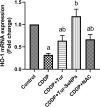Therapeutic activity of green synthesized selenium nanoparticles from turmeric against cisplatin-induced oxido-inflammatory stress and cell death in mice kidney
- PMID: 37902021
- PMCID: PMC10643052
- DOI: 10.1042/BSR20231130
Therapeutic activity of green synthesized selenium nanoparticles from turmeric against cisplatin-induced oxido-inflammatory stress and cell death in mice kidney
Erratum in
-
Correction: Therapeutic activity of green synthesized selenium nanoparticles from turmeric against cisplatin-induced oxido-inflammatory stress, and cell death in mice kidney.Biosci Rep. 2024 Oct 30;44(10):BSR-2023-1130_COR. doi: 10.1042/BSR-2023-1130_COR. Biosci Rep. 2024. PMID: 39469808 Free PMC article. No abstract available.
Abstract
Cisplatin (CDDP) is a commonly prescribed chemotherapeutic agent; however, its associated nephrotoxicity limits its clinical efficacy and sometimes requires discontinuation of its use. The existing study was designed to explore the reno-therapeutic efficacy of turmeric (Tur) alone or conjugated with selenium nanoparticles (Tur-SeNPs) against CDDP-mediated renal impairment in mice and the mechanisms underlying this effect. Mice were orally treated with Tur extract (200 mg/kg) or Tur-SeNPs (0.5 mg/kg) for 7 days after administration of a single dose of CDDP (5 mg/kg, i.p.). N-acetyl cysteine NAC (100 mg/kg) was used as a standard antioxidant compound. The results revealed that Tur-SeNPs counteracted CDDP-mediated serious renal effects in treated mice. Compared with the controls, Tur or Tur-SeNPs therapy remarkably decreased the kidney index along with the serum levels of urea, creatinine, Kim-1, and NGAL of the CDDP-injected mice. Furthermore, Tur-SeNPs ameliorated the renal oxidant status of CDDP group demonstrated by decreased MDA and NO levels along with elevated levels of SOD, CAT, GPx, GR, GSH, and gene expression levels of HO-1. Noteworthy, lessening of renal inflammation was exerted by Tur-SeNPs via lessening of IL-6 and TNF-α besides down-regulation of NF-κB gene expression in mouse kidneys. Tur-SeNPs treatment also restored the renal histological features attained by CDDP challenge and hindered renal apoptosis through decreasing the Bax levels and increasing Bcl-2 levels. Altogether, these outcomes suggest that the administration of Tur conjugated with SeNPs is effective neoadjuvant chemotherapy to guard against the renal adverse effects that are associated with CDDP therapy.
Keywords: cisplatin; inflammation; nephrotoxicity; oxidative stress; selenium nanoparticles; turmeric extract.
© 2023 The Author(s).
Conflict of interest statement
The experiment as well as the procedures and methodologies, were designed in compliance with the standards of Helwan University's Institutional Animal Care and Use Committee (IACUC) (approval no HU2021/Z/AES0921-02).
The authors declare that there are no competing interests associated with the manuscript.
Figures







Similar articles
-
Turmeric Extract-loaded Selenium Nanoparticles Counter Doxorubicin-induced Hepatotoxicity in Mice via Repressing Oxidative Stress, Inflammatory Cytokines, and Cell Apoptosis.Anticancer Agents Med Chem. 2024;24(6):443-453. doi: 10.2174/0118715206274530231213104519. Anticancer Agents Med Chem. 2024. PMID: 38204261
-
The integrated effect of roflumilast and selenium nanoparticles on nephrotoxicity generated by cisplatin through the regulation of the antioxidant and apoptotic pathways.J Trace Elem Med Biol. 2024 Dec;86:127555. doi: 10.1016/j.jtemb.2024.127555. Epub 2024 Oct 18. J Trace Elem Med Biol. 2024. PMID: 39442470
-
Using Green Biosynthesized Lycopene-Coated Selenium Nanoparticles to Rescue Renal Damage in Glycerol-Induced Acute Kidney Injury in Rats.Int J Nanomedicine. 2021 Jun 29;16:4335-4349. doi: 10.2147/IJN.S306186. eCollection 2021. Int J Nanomedicine. 2021. PMID: 34234429 Free PMC article.
-
Ameliorative impacts of polymeric and metallic nanoparticles on cisplatin-induced nephrotoxicity: a 2011-2022 review.J Nanobiotechnology. 2022 Dec 1;20(1):504. doi: 10.1186/s12951-022-01718-w. J Nanobiotechnology. 2022. PMID: 36457031 Free PMC article. Review.
-
Advances in nephroprotection: the therapeutic role of selenium, silver, and gold nanoparticles in renal health.Int Urol Nephrol. 2025 Feb;57(2):479-510. doi: 10.1007/s11255-024-04212-4. Epub 2024 Sep 23. Int Urol Nephrol. 2025. PMID: 39312019 Review.
Cited by
-
Poly lactic-co-glycolic acid enhances the efficacy of the phytomedicine chrysin against cisplatin induced toxicity in submandibular salivary glands.Sci Rep. 2025 Mar 25;15(1):10262. doi: 10.1038/s41598-025-93112-3. Sci Rep. 2025. PMID: 40133531 Free PMC article.
-
Protective role of curcumin and selenium nanoparticles against aluminium chloride-induced hepatorenal toxicity in rats.J Mol Histol. 2025 Jul 31;56(4):241. doi: 10.1007/s10735-025-10520-5. J Mol Histol. 2025. PMID: 40742469
References
-
- Lin W.-H., Jiang W.-P., Chen C.-C., Lee L.-Y., Tsai Y.-S., Chien L.-H.et al. . (2022) Renoprotective Effect of Pediococcus acidilactici GKA4 on cisplatin-induced acute kidney injury by mitigating inflammation and oxidative stress and regulating the MAPK, AMPK/SIRT1/NF-κB, and PI3K/AKT pathways. Nutrients 14, 2877 10.3390/nu14142877 - DOI - PMC - PubMed
Publication types
MeSH terms
Substances
LinkOut - more resources
Full Text Sources
Research Materials
Miscellaneous

